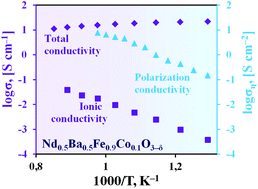Designing a protonic ceramic fuel cell with novel electrochemically active oxygen electrodes based on doped Nd0.5Ba0.5FeO3−δ†
Abstract
The Fe-based perovskite-structured Nd0.5Ba0.5FeO3−δ (NBF) system represents the basis for developing promising electrode materials for solid oxide fuel cells with proton-conducting electrolytes. This study aims at investigating the strategy of slight doping of neodymium–barium ferrite with some transition metals (M = Ni, Cu, Co) and examining the effect of this doping on the functional characteristics, such as phase structure, thermal expansion, total and ionic conductivity as well as electrochemical behavior, of Nd0.5Ba0.5Fe0.9M0.1O3−δ (NBFM) under testing in symmetrical cell (SC) and fuel cell (FC) modes of operation. Among the investigated dopants, cobalt (Co) is found to be the optimal dopant, resulting in an enhancement of transport properties and avoiding an undesirable increase in the thermal expansion coefficient. As a result, the electrode material made of NBFCo exhibits highest ionic conductivity and lowest polarization resistance in the SC mode of operation. Electrochemical characterization of the NBFCo cathode material in a protonic ceramic fuel cell (PCFC) followed by comparison of the obtained results with literature data demonstrates that NBFCo is an attractive cathode candidate for PCFC applications.



 Please wait while we load your content...
Please wait while we load your content...